



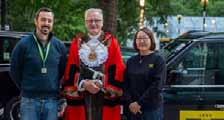


















Hello all,
Telephone: 020 7394 5553
E-mail for membership enquiries: thelcdc@gmail.com Web: www.lcdc.cab
Editor: Grant Davis
The Badge is distributed free to the Licensed London Cab Trade.
For advertising enquiries please contact the office on 020 7394 5553 or E-mail: thelcdc@gmail.com
All advertising in The Badge is accepted under our terms and conditions. These are available at the LCDC office. Before entering into any commitment, financial or otherwise, always remember to seek professional advice.
The views expressed in this publication are not necessarily those of the Editor or of the Management Committee of the London Cab Driver’s Club.
Contributions for publication are welcomed and should be sent to the Editor at the above address.
Printed by Iliffe Print. T: 01223 656500
I hope you have managed to recover from the disruption of last week’s RMT strikes. It was an incredibly challenging week for many, bringing significant pressure not only to our working lives but also on passengers who rely on us. While the additional work may have provided a short-term financial benefit, the reality is that constant disruption takes its toll on drivers.
On the front page and page 3, you’ll find my letter to LEVC raising serious concerns about the vehicle we are required to drive. I am aware that LEVC has been in discussions with TFL, but after reaching out directly to both TFL and other trade groups to request a meeting, I have been met with complete silence. No reply from either side - which is deeply disappointing, especially given the importance of these issues to our trade.
They say you can’t teach an old dog new tricks, but after 37 years of driving a cab, I (LCDC) have joined the WCHCD. After the Bank Junction fiasco, it’s clear to me that LCDC needs to ensure our voice is heard in the Square Mile - before decisions are made that continue to disadvantage working drivers.
On a lighter note, I’m writing this on Monday morning still smiling (and maybe slightly recovering) from a fantastic weekend at Disneyland Paris with the WCHCD. I’ve included an article in the Badge to share some of the highlights - let’s just say Mickey runs a smoother operation than TFL.
Grant Davis, LCDC Chair



Chairman
London Cab Drivers Club
Ansty Business Park,
Mr Alex Nan Chief Executive Officer
Coventry
Mr Alex Nan Chief Executive Officer
Mr Alex Nan Chief Executive Officer
The China Works Black Prince Road
London EV Company
CV7 9RF
London EV Company
Mr Alex Nan Chief Executive Officer
Grant Davis Chairman
London
Li Close
London EV Company
Mr Alex Nan Chief Executive Officer
Li Close
Li Close
Grant Davis Chairman
London EV Company
London
3rd September 2025
Li Close
Li Close
Ansty Business Park, Coventry
Ansty Business Park, Coventry
EV Company
Mr Alex Nan Chief Executive Officer
CV7 9RF
Ansty Business Park, Coventry
CV7 9RF

Ansty Business Park,
London EV Company
Ansty Business Park, Coventry
CV7 9RF
Coventry
Li Close
CV7 9RF
Dear Mr Nan
CV7 9RF
3rd September 2025
3rd September 2025
Ansty Business Park,
3rd September 2025
Coventry
3rd September 2025
3rd September 2025
CV7 9RF
Dear Mr Nan
Dear Mr Nan

3rd September 2025
Dear Mr Nan
Dear Mr Nan
Dear Mr Nan
Dear Mr Nan
London Cab Drivers Club
SE1 7SJ
Grant Davis Chairman London Cab Drivers Club
Grant Davis Chairman
The China Works
London Cab Drivers Club
The China Works
Black Prince Road
Grant Davis Chairman London Cab Drivers Club
London Cab Drivers Club
The China Works Black Prince Road
Grant Davis Chairman
The China Works
Black Prince Road
London
The China Works
Black Prince Road
London
SE1 7SJ
Black Prince Road
London SE1 7SJ
London Cab Drivers Club
London SE1 7SJ
SE1 7SJ
The China Works
London SE1 7SJ
Black Prince Road
London SE1 7SJ
Since LEVC’s announcement in early July that nearly half your workforce will be made redundant there has been an enormous amount of speculation within our London taxi trade. Many members of taxi organisations, including my own at the LCDC, are asking if this spells the end of the TXe purpose -built taxi, or might there be a new conversion based on the L380. Drivers are also very concerned about growing parts shortages.
Since LEVC’s announcement in early July that nearly half your workforce will be made redundant there has been an enormous amount of speculation within our London taxi trade. Many members of taxi organisations, including my own at the LCDC, are asking if this spells the end of the TXe purpose -built taxi, or might there be a new conversion based on the L380. Drivers are also very concerned about growing parts shortages.
Since LEVC’s announcement in early July that nearly half your workforce will be made redundant there has been an enormous amount of speculation within our London taxi trade. Many members of taxi organisations, including my own at the LCDC, are asking if this spells the end of the TXe purpose -built taxi, or might there be a new conversion based on the L380. Drivers are also very concerned about growing parts shortages.
Since LEVC’s announcement in early July that nearly half your workforce will be made redundant there has been an enormous amount of speculation within our London taxi trade. Many members of taxi organisations, including my own at the LCDC, are asking if this spells the end of the TXe purpose -built taxi, or might there be a new conversion based on the L380. Drivers are also very concerned about growing parts shortages.
Since LEVC’s announcement in early July that nearly half your workforce will be made redundant there has been an enormous amount of speculation within our London taxi trade. Many members of taxi organisations, including my own at the LCDC, are asking if this spells the end of the TXe purpose -built taxi, or might there be a new conversion based on the L380. Drivers are also very concerned about growing parts shortages.
Since LEVC’s announcement in early July that nearly half your workforce will be made redundant there has been an enormous amount of speculation within our London taxi trade. Many members of taxi organisations, including my own at the LCDC, are asking if this spells the end of the TXe purpose -built taxi, or might there be a new conversion based on the L380. Drivers are also very concerned about growing parts shortages.
Since LEVC’s announcement in early July that nearly half your workforce will be made redundant there has been an enormous amount of speculation within our London taxi trade. Many members of taxi organisations, including my own at the LCDC, are asking if this spells the end of the TXe purpose -built taxi, or might there be a new conversion based on the L380. Drivers are also very concerned about growing parts shortages.
I have recently written to TfL asking them for their understandin g of what is going on but received no response.
I have recently written to TfL asking them for their understandin g of what is going on but received no response.
I have recently written to TfL asking them for their understandin g of what is going on but received no response.
I have recently written to TfL asking them for their understandin g of what is going on but received no response.
I have recently written to TfL asking them for their understandin g of what is going on but received no response.
I have recently written to TfL asking them for their understandin g of what is going on but received no response.
I am therefore writing this open letter to you asking exactly how long LEVC intends to continue to build and sell the current dedicated purpose-built taxi, with the turning circle facility ? We note you said that you “…are actively discussing with regulators the requirements to support the development of an all-new TX”. This only increases speculation because, apart from being fully electric, what other requirements could there be, unless you are asking for changes to the Conditions of Fitness?
I am therefore writing this open letter to you asking exactly how long LEVC intends to continue to build and sell the current dedicated purpose-built taxi, with the turning circle facility ? We note you said that you “…are actively discussing with regulators the requirements to support the development of an all-new TX”. This only increases speculation because, apart from being fully electric, what other requirements could there be, unless you are asking for changes to the Conditions of Fitness?
I am therefore writing this open letter to you asking exactly how long LEVC intends to continue to build and sell the current dedicated purpose-built taxi, with the turning circle facility ? We note you said that you “…are actively discussing with regulators the requirements to support the development of an all-new TX”. This only increases speculation because, apart from being fully electric, what other requirements could there be, unless you are asking for changes to the Conditions of Fitness?
I am therefore writing this open letter to you asking exactly how long LEVC intends to continue to build and sell the current dedicated purpose-built taxi, with the turning circle facility ? We note you said that you “…are actively discussing with regulators the requirements to support the development of an all-new TX”. This only increases speculation because, apart from being fully electric, what other requirements could there be, unless you are asking for changes to the Conditions of Fitness?
I am therefore writing this open letter to you asking exactly how long LEVC intends to continue to build and sell the current dedicated purpose-built taxi, with the turning circle facility ? We note you said that you “…are actively discussing with regulators the requirements to support the development of an all-new TX”. This only increases speculation because, apart from being fully electric, what other requirements could there be, unless you are asking for changes to the Conditions of Fitness?
I am therefore writing this open letter to you asking exactly how long LEVC intends to continue to build and sell the current dedicated purpose-built taxi, with the turning circle facility ? We note you said that you “…are actively discussing with regulators the requirements to support the development of an all-new TX”. This only increases speculation because, apart from being fully electric, what other requirements could there be, unless you are asking for changes to the Conditions of Fitness?
I am therefore writing this open letter to you asking exactly how long LEVC intends to continue to build and sell the current dedicated purpose-built taxi, with the turning circle facility ? We note you said that you “…are actively discussing with regulators the requirements to support the development of an all-new TX”. This only increases speculation because, apart from being fully electric, what other requirements could there be, unless you are asking for changes to the Conditions of Fitness?
I have recently written to TfL asking them for their understandin g of what is going on but received no response.
We recognise the massive commitment LEVC has made to the London trade but equally our trade has spent over £600 million buying TXe taxis and my responsibility to drivers is to ensure their investment is protected. I understand that you will announce LEVC’s 2024 financial results in the next few weeks, but to halt the accelerated decline in driver numbers I would appreciate it you can give us real clarity on your future taxi strategy.
I look forward to hearing from you.
Yours sincerely
We recognise the massive commitment LEVC has made to the London trade but equally our trade has spent over £600 million buying TXe taxis and my responsibility to drivers is to ensure their investment is protected. I understand that you will announce LEVC’s 2024 financial results in the next few weeks, but to halt the accelerated decline in driver numbers I would appreciate it you can give us real clarity on your future taxi strategy.
We recognise the massive commitment LEVC has made to the London trade but equally our trade has spent over £600 million buying TXe taxis and my responsibility to drivers is to ensure their investment is protected. I understand that you will announce LEVC’s 2024 financial results in the next few weeks, but to halt the accelerated decline in driver numbers I would appreciate it you can give us real clarity on your future taxi strategy.
We recognise the massive commitment LEVC has made to the London trade but equally our trade has spent over £600 million buying TXe taxis and my responsibility to drivers is to ensure their investment is protected. I understand that you will announce LEVC’s 2024 financial results in the next few weeks, but to halt the accelerated decline in driver numbers I would appreciate it you can give us real clarity on your future taxi strategy.
We recognise the massive commitment LEVC has made to the London trade but equally our trade has spent over £600 million buying TXe taxis and my responsibility to drivers is to ensure their investment is protected. I understand that you will announce LEVC’s 2024 financial results in the next few weeks, but to halt the accelerated decline in driver numbers I would appreciate it you can give us real clarity on your future taxi strategy.
I look forward to hearing from you.
We recognise the massive commitment LEVC has made to the London trade but equally our trade has spent over £600 million buying TXe taxis and my responsibility to drivers is to ensure their investment is protected. I understand that you will announce LEVC’s 2024 financial results in the next few weeks, but to halt the accelerated decline in driver numbers I would appreciate it you can give us real clarity on your future taxi strategy.
I look forward to hearing from you.
We recognise the massive commitment LEVC has made to the London trade but equally our trade has spent over £600 million buying TXe taxis and my responsibility to drivers is to ensure their investment is protected. I understand that you will announce LEVC’s 2024 financial results in the next few weeks, but to halt the accelerated decline in driver numbers I would appreciate it you can give us real clarity on your future taxi strategy.
I look forward to hearing from you.
Yours sincerely
I look forward to hearing from you.
I look forward to hearing from you.
Yours sincerely
Yours sincerely
Yours sincerely
Yours sincerely
Grant Davis Chairman, London Cab Drivers Club
I look forward to hearing from you.
Grant Davis
Yours sincerely

Taxi Leaks reported a while ago that we had received information, that our regulator (TfL) had set up a team who were infiltrating certain 'members' only' FaceBook Taxi groups and were watching drivers' posts.
At first, this was an unsubstantiated report, but now TfL have openly admitted they are scrutinising posts and could bring action against what they referred to as "these angry trolls."
As our regulating body, TfL have failed miserably. They rarely answer their phones or reply to emails and have never put out any information, clearing up the problems applicable to Taxi Driver Licence renewals i.e. there is no mention on any TfL web pages of the Transport Act 1985 section 17, subsection 7 that allows your old licence to remain valid until you are in receipt of your renewal or conformation of a revocation.
So, you have been warned… be very careful with the content of your posts.
Grant Davis, Chair of the London Cab Drivers' Club (LCDC) attended a transport meeting at Palestra with deputy Mayor Seb Dance, TfL commissioner Andy Lord , Steve McNamara (LTDA), Trevor Merrills (UCG) and
Helen Chapman (TfL).
From Grant's online podcast, it appears the
What TfL did say… they will be making a statement about drivers on social media… what
especially on Facebook's Taxi members only groups, also on X (formerly Twitter).

meeting was mainly about tailpipe emissions. Grant asked if this was about reducing the age limit on Euro 6 and TXEs?
He said if this was brought in, it would be the final nail in the trade's coffin… but was met with deadly silence from the TfL contingent.
they referred to as "angry Twitter trolls."
They said they are fed up with the constant abuse on social media and admit they are watching everything driver's post.
Be very careful what you post on social media,
The TfL eye in the sky is watching you all the time. Big Brother are watching us…and you don’t want to wind up in room 101.
I have also been informed (by a friend who
works for TfLTPH), they are extremely worried about the amount of Taxi drivers who have left the trade/or retired, posting what they refer to as unsubstantiated stories on social media…and are exploring ways of possibly getting their social media accounts removed from the platform.
I have in the past personally been a 'victim' of losing my original FaceBook and Blogspot Google accounts with no explanation… and I can assure you it’s quite painful losing much cherished photos and videos of family and friends.
I always thought they would be safe on these platforms in respect of storage issues on my iPhone… but I was wrong.
A few years ago I was accidentally CC'd into an email where my X posts were being screen shot and sent to the director of TfLTPH.
I couldn’t post this email as it was clearly marked copyright, but I still have a screen shot in my possession (original email since removed by TfL).
So, if you are going to post anything about our regulator, please make sure you have evidence to back up your posts. Keep your evidence on your phone not just on your Facebook or X accounts.






















As

One of Britain's youngest councillors has claimed she was bullied out of the party after calling for CCTV to be installed in minicabs.
Daisy Blakemore-Creedon, 19, has left Peterborough city council’s Labour group after allegedly being bullied and subject to anti-Semitic abuse.
She said she was falsely accused of racism after raising concerns about the safety of passengers in Peterborough’s minicabs, many of which are driven by Asian men.
She said councillors accused her and her wider family of “targeting fellow Asian Labour councillors”.
Ms Blakemore-Creedon argued in favour of CCTV being installed in councillicensed minicabs, but the move was voted down by
the party’s minority-ruling administration. She has flatly denied any accusations of racism.
Ms Blakemore-Creedon, whose mother is Jewish, will now sit on the council as an independent and she has said she is disappointed because ‘Labour is in my blood’.
“I’m so disappointed with
all this because my morals have always been Labour. Labour is in my blood. My grandfather was a major supporter. But my entire family have been left really disappointed as well,” she said.
“When I argued for more safety measures in minicabs it led to a lot of ugly comments by people in the Labour group. I got

messages from fellow Labour councillors accusing me of racism because lots of the cab drivers are Asian.
Daisy Blakemore-Creedon, 19, has left Peterborough city council’s Labour group amid accusations of bullying and anti-Semitic abuse
“But I wasn't targeting Asian drivers. I was talking about safeguarding for everyone, passengers and drivers.”
She announced her resignation from Labour on Monday in a message on X: “I feel as though I have sustained bullying and marginalisation within the group after raising serious concerns - concerns which, in my view, were not treated with the seriousness they deserved,' she said.
“Following this, I was deeply disturbed to find myself accused of racism, with suggestions that I and
my family were "targeting fellow Asian Labour councillors".
“These accusations are completely unfounded and deeply hurtful. I have also raised a formal complaint regarding these matters, which has now been delayed twice, reportedly due to concerns about the political impact on the party, rather than a focus on justice or resolution.”
Leader of Peterborough city council and of the Labour group, Dennis Jones, said that he was 'disappointed' by Ms Blakemore-Creedon's decision to resign.
A Labour Party spokesperson added: “All complaints are assessed thoroughly in line with the Labour Party's rules and procedures.”
Courtesy of LBC



By Claude
Brian Rice, the self-styled “benevolent dictator” who chaired Dial-a-Cab (DaC), London’s oldest radio-taxi co-operative, has died in his seventies. His passing in August 2025 has prompted mixed reactions within the London taxi trade, with some remembering his early stabilising influence while others reflect on the controversial decisions that led to the co-operative’s eventual demise.
Rice’s tenure began with promise, stabilising a faltering organisation in the 1990s, but ended in catastrophe, marked by authoritarian control, resistance to technological innovation, and strategic decisions that ultimately empowered competitors at DaC’s expense. Through systematic silencing of dissent, rejection of modernisation, and the fateful introduction of the “Concierge” platform, Rice transformed a driver-owned institution that could have led the industry into the digital age into a cautionary tale of institutional decline.
1990s: Stabilising a Struggling Co-operative Milestone: Rice Takes Charge Amid Crisis
Founded in 1953, Dial-aCab grew into a powerhouse by the 1980s, boasting a large fleet, prestigious corporate accounts, and a “friendly society” structure prioritising driver-members. By the early 1990s, economic turbulence and a cautious board prone to indecision had left DaC struggling. Rice, assuming the chairmanship, brought decisive leadership, restoring stability and confidence.
He boasted of “making £1
million in profit” (Call Sign, December 2003), a curious claim for a non-profit mutual where surpluses should have funded innovation or driver benefits. While his early tenure steadied the co-operative, Rice’s focus on short-term gains
ultimately destroy DaC from within. By granting PH operators access to DaC’s fleet and corporate clients, Rice enabled them to meet demand while building their own driver networks. Critically, “Concierge” diverted journeys over six
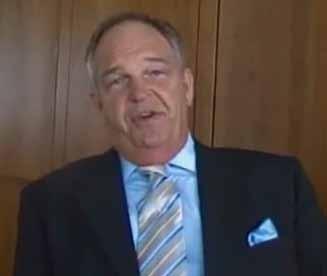
and reluctance to invest in technology sowed the seeds of future decline.
1998: The Private Hire Act and the “Concierge” Trojan Horse Milestone: Empowering the Competition
The 1998 Private Hire Act reshaped London’s transport landscape by licensing minicab operators, legitimising private hire vehicles (PHVs) and intensifying competition. Rather than fortifying DaC against this new threat, Rice saw an opportunity for profit. He introduced the “Concierge” platform, allowing PH operators to use DaC’s infrastructure for account work at premium rates. Rice hailed this as “brilliant business,” believing he was outsmarting competitors by charging them heavily.
This proved to be a strategic catastrophe—a Trojan Horse that would
miles to PHVs instead of DaC’s taxis, directly reducing earning opportunities for the co-operative’s own drivers. Once established using DaC’s infrastructure, PH firms inevitably poached clients by offering lower rates directly, systematically eroding the co-operative’s market share.
Dissenters like Darryl Cox and Grant Davis of the London Cab Drivers Club (LCDC) raised urgent alarms about “Concierge” and the strategic folly of subsidising PHVs with taxi resources. Their concerns, voiced in Call Sign and The Badge, were met with expulsion and personal attacks, silencing early warnings that proved prophetic.
In the February 2011 issue of The Badge, Darryl Cox highlighted the opacity surrounding Concierge in DaC’s annual report: “Finally, and most ominously, there is no mention of Mr Rice’s pride and joy, Concierge. As
usual there are, of course, no operating details.” Cox suggested this silence might indicate the platform had become a financial burden, taking work away from members exactly as critics had predicted.
2000s: Authoritarian Control and Silenced Critics
Milestone: Systematic Suppression of Dissent
Rice’s leadership style grew increasingly authoritarian as he consolidated control over the Board of Management. He bullied committee members, reducing their influence and cutting their hours to eliminate opposition. When a proposal emerged to professionalise DaC by hiring external management experts under board supervision, Rice derailed it by demanding the Chief Executive role for himself with a £200,000 annual salary—effectively killing the reform initiative. This ensured DaC remained under the control of a board ill-equipped for the rapidly changing transport industry.
Critics faced severe consequences. Tony Gillam, who challenged Rice’s direction, was marginalised and eventually expelled.
As Darryl Cox revealed in The Badge (July 2010): “Mr. Fisher also alluded to fact that Mr. Gillam was expelled from DAC, not surprisingly he does not mention the fact that this was done ILLEGALLY. After a protracted court case once again costing members of DAC huge amount of money, Mr. Gillam won his case and DAC was forced to pay compensation.”
Michael Calvey, a Council of Management member at the Licensed Taxi Drivers’ Association (LTDA) and vocal critic, was similarly expelled. Darryl Cox and
Grant Davis, who persistently protested the Concierge strategy and other strategic errors, were also thrown out. These expulsions, often conducted in violation of DaC’s own rulebook, silenced the co-operative’s most prescient voices— modern Cassandras whose warnings of institutional decline went unheeded.
The pattern of Rice’s responses to criticism revealed his intolerance for debate. When Grant Davis questioned a subscription increase in Call Sign (December 2003), arguing that with substantial reserves, DaC should exemplify how a friendly society works for its members, Rice dismissed him as a “moaning old git.”
Similarly, when Tony Lawyer questioned the necessity of fee increases, Rice deflected with sarcasm and personal attacks rather than addressing substantive concerns.
In The Badge (July 2010), Darryl Cox wrote: “under the present management the future of DAC appears to be in permanent decline.”
Grant Davis added a pointed critique: “What gall coming from a man that openly boasts that he has not had to drive a licensed taxi for over 15 years, and how can he possibly still hold a licence?… I respectfully suggest to Mr Rice that he should start doing the job he is well paid to do, which is to look after the welfare of his members, after all he works for them not the other way round.”
2003: “Texting Is for Kids” – The Great Technology Rejection Milestone: Dismissing Digital Innovation
By 2003, mobile technology
was transforming consumer behaviour across industries. At the Taxi and Private Hire Show, exhibitors showcased text-based dispatching and mobile credit card payments—technologies that could have modernised DaC’s operations and maintained its competitive edge. When urged by members to consider these innovations, Rice rejected them outright.
This dismissal of text messaging as unsuitable for DaC’s demographic was catastrophic. Rice’s caricature of the cooperative’s clients as elderly and technology-averse ignored the growing digital preferences of younger professionals—the very market that Uber would capture within a decade. His claim that a competitor’s text system would take “120 years” to pay off revealed a profound misunderstanding of digital scalability and network effects.
The consequences of this technological rejection became apparent when Russell Hall, a frustrated DaC driver, left to cofound Hailo—an appbased platform that briefly challenged both traditional radio circuits and early ride-hailing services. Hall’s departure represented a direct loss of innovation talent that could have kept DaC competitive. Instead of embracing such initiatives, Rice viewed them as threats to his control, ensuring DaC remained dependent on an aging radio system prone to outages and delays.
Milestone: Professional Advice Ignored
During this period, a forensic accountant warned that DaC was financially vulnerable despite Rice’s public claims of prosperity. The accountant urged comprehensive modernisation, including credit card settlements and expansion into individual customer markets— precisely the areas that Uber would later dominate. Rice ignored these professional recommendations, instead
pursuing a strategy of expanding membership to dilute available work while cutting fares to chase volume.
The financial situation was more precarious than Rice publicly acknowledged. Despite his earlier claims of £5 million in reserves (later corrected to £1.5 million), DaC relied on driver-funded overdrafts to sustain costly corporate accounts—a model that was becoming increasingly unsustainable as competition intensified.
Milestone: Competitive Collapse
By the mid-2010s, appbased platforms had revolutionised the transport industry with instant bookings, transparent pricing, and seamless payment systems. These were precisely the innovations Rice had dismissed as unsuitable for DaC’s business model. Corporate clients, attracted by the efficiency and cost-effectiveness of PH operators—many of whom had built their capabilities using DaC’s own Concierge platform—began defecting en masse.
The irony was stark: Russell Hall’s Hailo, cofounded by a former DaC driver, demonstrated exactly what the cooperative could have achieved had it embraced rather than rejected innovation. Rice’s response was characteristically authoritarian. In July 2014, he banned DaC members from using Hailo.
Internal dissent reached a crescendo. In November 2014, Javid Raja wrote in Call Sign: “My feeling is that due to the shortcomings of the BoM, we now find ourselves on the brink of disaster… As the BoM have failed, they should now, with good grace, step aside.” His description of Concierge as “Work given to peasant minicab companies, run by parasites” reflected the frustration of drivers who watched their co-operative
subsidise its own destruction.
By 2018, the inevitable had occurred. Rice was forced to acknowledge that “Dial-A-Cab has been loss making for some time” and that the co-operative’s “cash reserves that we have built up in the good times have helped sustain us while we have looked at the alternatives for the business.”
The only remaining asset of value was DaC’s East Road
Rice’s leadership failures.
Following Rice’s death in August 2025, reactions within taxi trade circles reflected the complex legacy he left behind. Some remembered his early contributions during DaC’s stable years, while others remained critical of decisions that fundamentally altered London’s transport landscape. The fact that his passing received limited coverage in major taxi trade
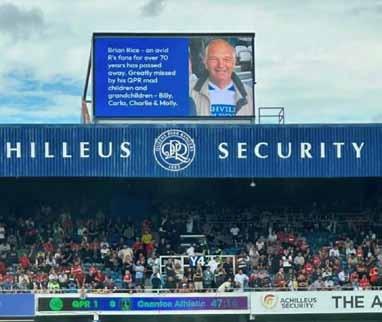
headquarters.
Rather than attempting a technological transformation that might have saved the co-operative, Rice pushed for demutualisation. CityFleet, part of Singapore’s ComfortDelGro, acquired DaC for £1.2 million—a fraction of what the cooperative might have been worth had it maintained its market position. Members received approximately £20,000 each as the headquarters was marked for demolition.
While some older drivers praised Rice for securing this final payout, for many it represented the ultimate betrayal: the independence and mutual ownership that had defined DaC for 65 years was traded away for immediate cash.
The expulsions of Gillam, Calvey, Cox, and Davis—all of whom had warned of exactly this outcome—stood as a damning indictment of
The “Concierge” platform stands as perhaps the most damaging strategic decision in London taxi history—a scheme that used DaC’s own resources to build competitor networks while simultaneously training the market to bypass traditional taxis for longer journeys.
Rice’s dismissal of digital innovation, epitomised by his rejection of text messaging as being “for kids,” left DaC defenseless against the app-based revolution that transformed urban transport.
His systematic expulsion of critics—often through illegal means that resulted in costly legal defeats—eliminated the internal checks and balances that might have prevented these strategic errors. The loss of drivers like Russell Hall, who went on to co-found Hailo, represented not just individual departures but the haemorrhaging of innovative talent that could have positioned DaC at the forefront of industry transformation.
publications itself suggests the diminished influence of the institution he once led.
Grant Davis, now Chairman of the LCDC and one of the critics Rice expelled, has continued advocating for driver rights and proper governance within taxi organisations—work that takes on additional significance given DaC’s fate under Rice’s leadership.
Brian Rice’s 20+ year tenure represents one of the most significant institutional failures in London transport history. He inherited a thriving mutual organisation with substantial resources, loyal membership, and strong market position, yet presided over its systematic dismantlement through a combination of strategic errors, authoritarian governance, and resistance to necessary change.
A lifelong Queens Park Rangers supporter who grew up in Shepherd’s Bush and settled in Yateley, Rice remained connected to his West London roots throughout his tenure.
To some, particularly older drivers who benefited from the final payout, he was a pragmatic leader who secured what he could from a deteriorating situation.
To the broader taxi trade and the expelled members whose warnings went unheeded, Rice’s legacy is more complex: a chairman who stabilised DaC in crisis but ultimately failed to adapt to changing times, choosing personal control over institutional survival.
This article draws on extensive documentation from Call Sign magazine and The Badge, publications of the London Cab Drivers Club, which provide detailed records of internal debates and decisions during Rice’s tenure. Contemporary sources and trade publications were consulted to provide balanced context on his death and legacy.
After a week of hard graft in the Cab, I found myself on occasions stuck in traffic dreaming of that Saturday morning without an alarm clock... but the alarm clock went off on Friday at 3.30am and it was the start of my amazing Disneyland Paris weekend...
I had never been on this trip before and did not know what to expect, but I can tell you now, it's one of the most rewarding weekends I have ever experienced. Picking up my allocated family, then the journey through London at 4.30am making my way to Canary Wharf, it felt different and I felt a buzz of excitement building.
The breakfast with all the kids, drivers, other livery
hall personnel and French police, you just knew this was going to be special.
We set off from Canary Wharf with the police not only giving us an escort, but all the way down to Dover they held back traffic at all roundabouts and junctions to let the Cabbie Convoy travel as one long line, it was an incredible sight.
On the ferry, then off the ferry at Calais and this time the French police joined us and gave the taxis an escorted journey to EuroDisney... Fantastique!
Our amazing passengers were a joy to behold and to see the happiness the trip was giving to them was in itself immensely rewarding. As a parent

myself, seeing our children enjoying themselves is a gift and all the children who were taken had a non-stop weekend of fun.
I just wanted to also say that the taxi drivers who attended were an absolute credit to our trade - they were helpful, polite, considerate and showed immense compassion for their very special passengers and also their accompanying parents. A


more "solid" bunch of men and women drivers you would be hard pushed to find, a real credit and I look forward to saying hello out on the streets.
What a weekend and a big thank you to the WCHCD committee for all their hard work, it's a massive team effort and again, what a credit to our trade you all are.
Grant Davis, LCDC Chair




In 2000, a young girl named Rachael, then battling Acute Lymphoblastic Leukaemia, joined the Children’s Magical Taxi Tour – the annual convoy of London taxis that takes children with serious illnesses on an unforgettable trip from Canary Wharf to Disneyland Paris.
For Rachael, the adventure provided a rare moment of joy and normality amid gruelling treatments. Just months later, in April 2001, she went into remission, but by August the leukaemia had returned. What followed was three long years of chemotherapy and radiotherapy, along with further treatments including growth hormone therapy. Despite missing



significant time at school due to hospital stays and appointments, Rachael’s determination never wavered.
The trip in 2000 was also life-changing in another way. Her driver, Jamie, who had volunteered to take Rachael and her mum to Disneyland, became a close part of their lives. Shortly before Rachael relapsed, her mum and Jamie began a relationship, and when she turned 18, Rachael chose to change her surname to his – a reflection of the bond they had built. Jamie remains incredibly proud of Rachael, not only for overcoming years of treatment, but also for all that she has achieved since. “She lost so much time in hospital, yet she has never let that hold her back. I am so proud to call her my



daughter,” he said.
Now, 25 years after that first magical journey, Rachael will return to the Children’s Magical Taxi Tour – but this time in the driver’s seat. She will be joining the
convoy of taxis once again, transporting children with life-threatening illnesses to Disneyland Paris, just as she was once taken.
Rachael is thrilled to be part of the event from a
new perspective: “The Taxi Tour gave me so much hope and happiness at a time when I needed it most. I want the children coming on the trip this year to see that there is life beyond treatment, and that even when things seem very hard, there is a future waiting for them. I can’t wait to help make their journey as magical as mine was.”
The Children’s Magical Taxi Tour has, since 1994, offered hundreds of children and their families a chance to escape hospitals and treatments for a few days of joy, thanks to the generosity of London taxi drivers, volunteers, and sponsors. Rachael’s story stands as a powerful testament to the lasting impact of the event, and the hope it continues to inspire.
Transport for London (TfL) likes to describe itself as a world-class regulator. The truth is very different. TfL is a failed regulator — neglecting its duty to protect the public, failing its equality obligations, and bending to the will of Private Hire Operators, such as Uber, rather than upholding the licensing system Parliament intended. Because other licensing authorities across the country mimic TfL’s approach, these failures are not confined to London — they reverberate nationwide.
Historically, private hire licensing was tied to geography. The Greater London Authority (GLA) boundary defined where TfL-licensed vehicles and drivers could operate. This system had one clear purpose: public safety through enforceability. Within London, TfL’s enforcement officers could inspect vehicles and drivers and protect passengers.
The boundary mattered because inside the GLA there is TfL oversight. Outside it, TfL have no reach — rightly so, because local authorities have their own licensing and enforcement systems.
This safeguard has been dismantled not by legislation but by TfL’s regulatory negligence and weakness. TfL has allowed Uber to redefine London on its Private Hire operation to extend well beyond the GLA boundary. As shown
in the map, “London” now reaches East Hertfordshire, St Albans, Guildford, and other outof-London districts.
The required “invitation and acceptance” of bookings — a legal requirement — now takes place in locations that are unclear: Uber’s London office, in the cloud on remote servers, or on the driver’s phone and backfilled to the operator.
The result: a regulatory failure. TfL officers are not stationed in East Hertfordshire, St Albans, or Guildford. Local licensing officers cannot enforce rules on TfL licensed vehicles and drivers. Passengers are left without the safety protections the system was designed to guarantee.
The Licence Fee That Should Exist
If TfL were fulfilling its responsibilities, it would have a rational licensing fee structure for large operators like Uber (10,000+ vehicles), such as:
• Operate only inside London (GLA boundary): £2.9 million over five years (£580,000 per year) as per the current fee:
• Operate outside London (expanded area) creates an additional licensing fee of: £26.25 million over five years (£5.25 million per year).
This higher licensing fee reflects the actual cost of ensuring public safety for TfL enforcement in areas outside the Greater London boundary where Uber operates TfL-licensed drivers and vehicles. An estimated 150 additional enforcement officers— each costing £35,000 per year—would be required,
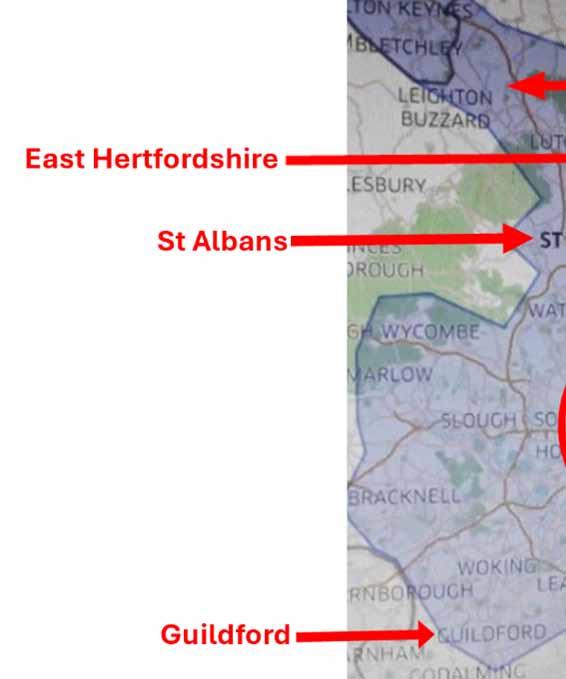
although this number could be higher.
150 × £35,000 = £5,250,000 per year = £26,250,000 over five years.
If Uber challenged this new licensing fee structure for operating TfL licensed vehicles and drivers outside of the Greater London boundary, TfL’s defence is straightforward: if Uber wants to operate in East Hertfordshire, St Albans, Guildford, or elsewhere
outside London, it can apply for local operator licences. This is exactly how Parliament designed the system, with the “Triple Lock” — operator, driver, and vehicle all licensed by the same authority.
Preventing unsafe cross-border hiring is straightforward: TfL simply needs to enforce the rules that already exist. However, this first requires the Department for Transport (DfT) to address TfL’s
operational negligence, since TfL’s taxi and private hire department is an emanation of the state. Parliament retains ultimate authority, with the explicit power to grant delegated powers and to revoke them if those powers are not properly exercised by the bodies to which they have been delegated.
Duty and Negligence: A Public Law Failure
From a public law perspective, TfL’s failures

are serious.
• Duty of care in regulation: TfL has a statutory duty to regulate private hire operators, drivers, and vehicles in a way that protects public safety.
• Negligence by omission: TfL knows its licensees are operating outside its greater London enforcement boundary but has failed to implement oversight or charge fees to cover enforcement outside
of the greater London enforcement boundary.
• Foreseeability of harm: Cross-border hiring undermines passenger safety and equality obligations. Disabled passengers may not receive proper assistance, and local police are forced to intervene — risks that are foreseeable, significant, and ongoing.
• Unlawfulness under public law: Following Padfield v Minister of
Agriculture, a regulator that frustrates the statutory purpose acts unlawfully. By allowing Uber to treat “London” as far beyond the GLA, TfL has frustrated Parliament’s licensing regime.
TfL’s conduct is not just negligent — it is arguably unlawful.
TfL is also in breach of the Public Sector Equality
worked: London vehicles stayed in London under TfL oversight, and local authorities regulated their own licensed private hire vehicles and drivers. Public safety was protected.
TfL abandoned this model, surrendered to Uber, and created a regulatory vacuum. The consequences are stark:
• Public safety is compromised. TfL licensed vehicles and drivers operating outside London are unchecked.
• Equality rights are undermined. Disabled passengers outside London cannot rely on enforcement.
• Costs are externalised. Local council tax taxpayers fund police enforcement that TfL should provide.
• The failure spreads nationally. Other licensing authorities following TfL’s lead mean cross-border chaos is now nationwide.
Duty (s.149 Equality Act 2010). It is obliged to eliminate discrimination, advance equality, and ensure disabled passengers receive the assistance they are entitled to. By refusing to enforce outside London, TfL leaves disabled and vulnerable passengers in areas like East Hertfordshire unprotected. This is regulatory negligence.
The historical system
TfL claims to be a worldclass regulator. The truth is the opposite: TfL is negligent and a failed regulator, submissive to Uber, and derelict in its duty to protect the travelling public. Until TfL reinstates clear boundaries or the DfT/ Parliament forces TfL to reform its licensing fee structure, and enforces licensing law as intended, cross-border hiring will remain a safety risk, an equality breach, and a public law failure.
Suddenly, cross-border hiring looks far less attractive for private hire operators when TfL regulation starts to focus on public safety and its Public Sector Equality Duty.
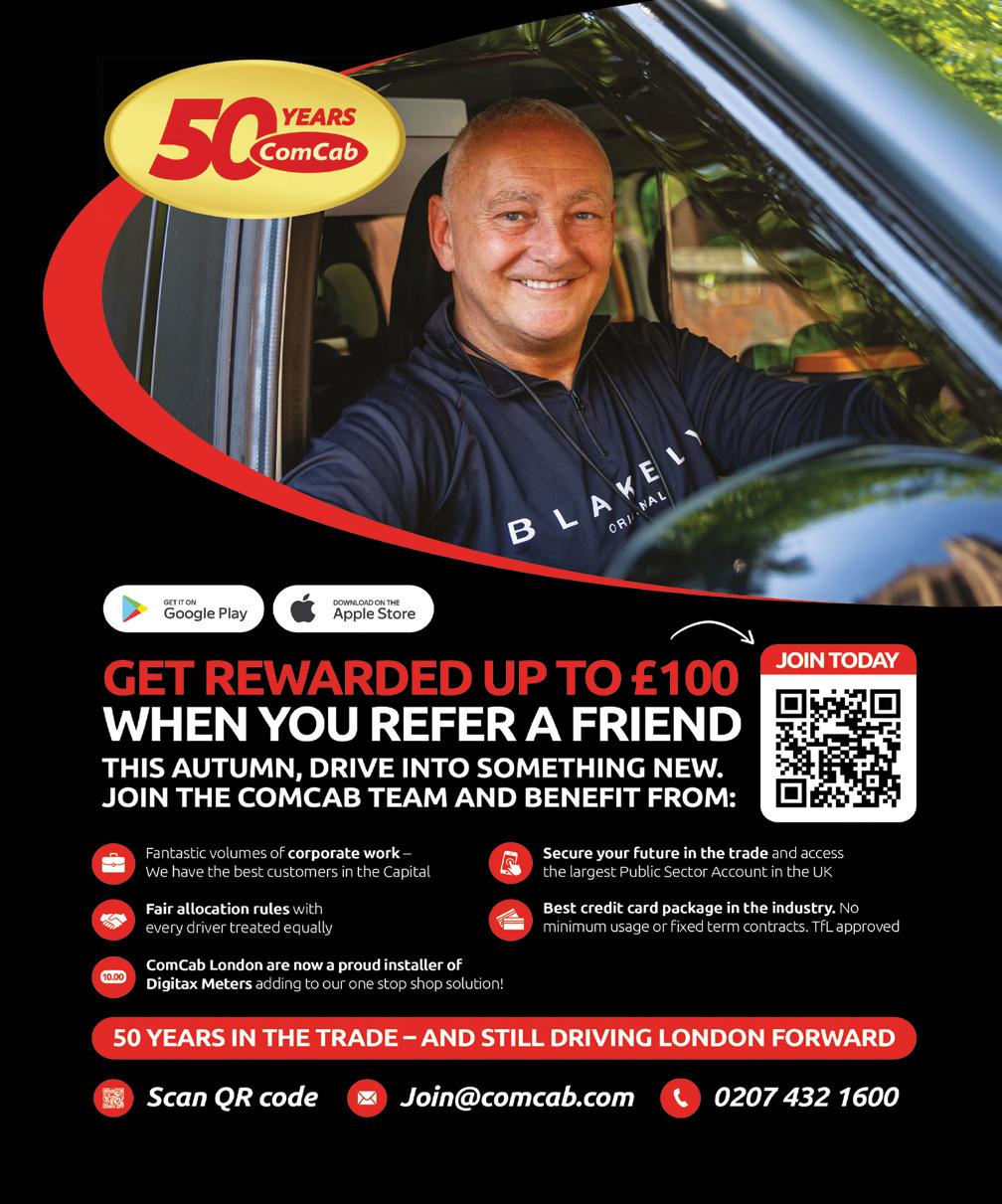


LONDON, 8 September
2025: Sherbet, the UK’s leading electric black taxi company, has raised ~£40 million in supportive growth capital from European private equity firm Hoplon Investment Partners, marking the largest single investment in the history of the licensed London taxi trade.
Founded in 2013 by British entrepreneur and former black cab driver
Asher Moses with a mission to transform the world’s most recognisable taxi into a zero-emissions, techenabled mobility platform, Sherbet now operates the UK’s fastest-growing electric black cab fleet.
With this fresh investment, the Company has aspirations to expand from 550 to 3,000 vehicles through selective opportunities, build out new driver-focused technology, and prepare for international rollout, repositioning the black cab as a global symbol of sustainable mobility.
Asher Moses, CEO at Sherbet, said: “This investment marks a turning point, not just for Sherbet, but for the future of the black cab industry.
“The black cab is a globally recognised symbol of London - trusted, iconic, and deeply woven into the city’s identity. Yet for too long, it’s lacked a dedicated guardian committed to its modernisation.
“Our mission is to step into that role, not only to preserve its heritage, but to equip the trade with the technology, data and scale it needs to thrive in the current modern mobility landscape.
“With this investment, we’re laying the foundation to reposition the licensed

industry and establish Sherbet as its new home: electric, innovative, and built for the future.”
The investment reflects growing confidence in Sherbet’s ability to deliver a smarter, cleaner and more connected taxi experience. As the first fully electric fleet of licensed black cabs, Sherbet is building a platform that modernises the trade, empowers drivers, and sets a new benchmark for sustainable urban transport. This funding positions the company to consolidate the licensed industry and expand its model internationally.
Sven Hansen, Co-founder and Managing Partner at Hoplon Investment Partners said: “Sherbet is redefining
what it means to be a modern mobility company. Asher’s vision blends the legacy of the black cab with a forward-thinking, data-led approach to electrification and driver empowerment. We’re proud to support Sherbet’s growth in London and its expansion into international markets.”
The raised investment will be deployed across several strategic initiatives:
• Fleet expansion: Scaling Sherbet’s owned fleet from 550 to 3,000 electric taxis over the next three years, offering independent drivers and fleet owners a new home under the Sherbet brand.
• Technological integration: Developing
a comprehensive fleet platform that provides drivers with access to bookings, data, out-ofhome (OOH) advertising, and advanced analytics to increase earnings and job security.
• Competitive positioning: Leverage Sherbet’s regulated, trusted brand to outpace unlicensed ride-hailing apps through a combination of heritage, innovation, and compliance.
• Driver pipeline: Investing in the next generation of Knowledge School entrants to ensure the long-term sustainability of the trade.
• Passenger assurance: Safeguarding accessibility and reliability for all Londoners, particularly
wheelchair users who depend on the black cab network's unique accessibility features.
• Urban data infrastructure: Equipping every taxi with advanced analytics capabilities to provide real-time environmental, traffic, and road safety data to local authorities, supporting London's smart city initiatives.
Sherbet’s innovative model has already attracted interest from cities worldwide seeking to replicate its success. With this investment, the company is positioned to export its platform internationally, establishing the London black cab as a global symbol of sustainable urban mobility.

Khan has reportedly accumulated enough miles on international trips over the course of the last eight years to travel to the Moon and back, an new analysis has suggested.
The investigation examined the Mayor of London’s travel records and found that Mr Khan has flown more than 73,000 miles alone, with the total rising to over 473,000 miles when accounting for accompanying staff.
These flights produced an estimated 43.6 tonnes of carbon dioxide over 13 separate trips, roughly equivalent to flying 19 times around the Earth’s equator. In total, the mayor’s office purchased at least 70 seats on international flights, enough to fill a small short-haul aircraft.
Some trips included large entourages, such as an eight-person team that accompanied Mr Khan to New York last September when he represented C40 Cities at an international climate conference.
Data from 2023 and 2024, collated by The Telegraph, shows Mr Khan travelling with 23 staff members on four trips to New York, Rome, and Paris, two of which were climate-related events. Previous years included trips to India and Pakistan in 2017 with seven staff at a cost of nearly £21,000, and a 2016 trip to Canada and the USA with a team of seven, costing over £32,000.
Analysts estimate that between 1,350 and 2,000 trees would need to be planted in a year to offset the carbon produced by these journeys, which is

comparable to half the annual carbon absorption of Hyde Park’s trees.
Mr Khan has faced criticism for these trips, with opponents questioning whether his overseas travel aligns with his public stance on climate issues. Victoria Atkins, shadow secretary of state for environment, food, and rural affairs, said: “Anyone who lives, works, or visits London knows how it has become one giant traffic jam under Mr Khan.
"In a textbook example of Left-wing hypocrisy, ‘Climate Khan’ is happy to close roads, drive up costs for drivers and waste our time in jams,
whilst preaching net zero from the comfort of his many plane journeys."
Mr Khan has historically opposed expansions at Heathrow Airport, including the proposed third runway. In June 2023, he told reporters: “We don’t want more flights.” In January 2025, he added: “I remain opposed to a new runway at Heathrow Airport because of the severe impact it will have on noise, air pollution and meeting our climate change targets.
"I’m simply not convinced that you can have hundreds of thousands of additional flights at Heathrow every
year without a hugely damaging impact on our environment.”
On the use of private jets, he said in May 2023: “Frequent air travellers should consider firstly whether a particular journey is needed at all and, if so, to take the lowest carbon options wherever possible.” Mr Khan has repeatedly encouraged Londoners to reduce their carbon footprint.
"Speaking at the 2016 launch of his action plan to tackle air pollution, he said: “With nearly 10,000 people dying early every year in London due to exposure to air pollution, cleaning up London’s
toxic air is now an issue of life and death.” In 2022, he announced the expansion of the Ultra Low Emission Zone (Ulez) across Greater London, describing clean air as a “right not a privilege.”
A spokesperson for the Mayor of London said: “The mayor has made 16 international visits by plane, compared to 34 visits by plane made by Boris Johnson when mayor. Mr Khan makes no apology for banging the drum for the capital overseas to promote growth and to generate new trade, investment and cultural links.”
Courtesy of The Express
Two-tier justice favours the Mayor of London against the little man, even though TfL are patently guilty.
Not many cabbies will disagree that the despotic Sadiq Khan is indeed destroying London economically and socially, and making the lives of traditional London taxi drivers as difficult as possible.
Every which way one looks, the Mayor of London has his grubby hands in negatively affecting small business viability, nighttime entertainment, road user transport, and the safety of the Capital’s residents and visitors.
There is no greater evidence of his blatant disregard for our Capital’s vital road users than his persistent arrogance in ignoring legal decisions that have gone against him, particularly through his expensive refusal to make London’s LEZ and ULEZ signs fully compliant.
On 3rd September, I saw yet another example of the national epidemic of two-tier justice. This one favours Transport for London at the Royal Courts of Justice.
The Claimant, Noel Willcox, took on Transport for London in the county courts for the third time in four years.
In two previous court cases, Noel Willcox demonstrated that the LEZ and ULEZ signage across London is unlawful. Noel won both these earlier cases, yet TFL has continued to charge motorists, fully aware that the signs are illegal.
The basis of the case is

that scaffolding company owner Mr. Willcox has accused Transport for London of employing what he called “bully boy tactics” by ignoring the ruling, issued by a traffic tribunal court in 2021.
Mr Willcox appeared in court in 2021 and 2023 after being hit with a hefty £11,500 in fines related to his company's truck driving to and from his depot headquarters in north-west London.
TFL has employed every trick in the book to undermine Noel Willcox through various means, including via administrative errors.
TFL has acknowledged that the signage is both incorrect and unlawful. They were previously defeated in the courts by this brave small businessman, who clearly demonstrated that all LEZ (and ULEZ) road signage is indeed illegal.
TFL’s defence, which the judge also appeared to
accept too readily, is that the cost of stopping the LEZ and ULEZ projects would be enormous and would significantly impact air quality.
It appears that, although Mr. Willcox was justified, highlighting London’s signage does not meet authorised standards, and by proving this at his own personal expense, the Court Judge concurred with TFL’s decision to strike out the Claimant's case. To add insult to the Judges' decisions, costs were awarded against Noel Willcox. However, he has the right to appeal to a Circuit Judge within 21 days.
As my good friend, one of the Tooting four, Nick Arlett, who beat Khan’s attempt to prosecute him for campaigning against the ULEZ expansion, wisely comments on Noel Willcox’s case: “The Judge in the Noel Wilcox case used what was effectively an impact statement, i.e.,
the financial cost plus the alleged threat to TFL services, as part of his reasoning for his ruling. Why? ..Why did a Judge take the financial implications into account when passing judgment... Surely that comes under the heading of mitigation?”
Mitigation is usually only mentioned after a guilty verdict is reached in an attempt to reduce the sentence. Similarly, after a guilty verdict, there can be a Victim's Impact Statement given to the court before sentencing.
The point being... Mitigation is only submitted AFTER a guilty verdict and before sentencing, and should have absolutely NO relevance to guilt or innocence.”
There is no doubt in my mind that the Judge in this case acted in favour of the Defence for TFL and was biased against Noel.
This is a classic David and Goliath scenario, demonstrating that the large, well-funded establishment, staffed with highly paid, politically left lawyers, always overpowers the smaller individual.
Every right-thinking, honest person should support Noel Willcox’s appeal and show the Judiciary that giving the clearly guilty party a lenient ruling to avoid possible bankruptcy is not only unfair but also seems to be a coordinated act of dishonesty.
By targeting Noel personally and refusing to pay his charges, as ordered by previous courts, TFL has shown that it is deliberately extorting drivers through illegitimate emissions charges and fines.
Mayor Sadiq Khan knows that his costly and ineffective TfL scheme is illegal. Yet, he continues to charge tax-paying businesses and drivers for his vanity project that cripples the city. The project was created to promote his political ambitions and agenda, not to improve London's air quality.
TFL said the consequences if Noel had won could result in hundreds of thousands of people receiving refunds for paying to drive in London in the LEZ and ULEZ zones and the suspension of the schemes.
A TfL spokesman said: "The LEZ signs were deemed lawful by the DfT in 2008, and the ULEZ signs received the same authorisation ahead of their introduction and expansions.
"Due to a processing
error, the correct evidence was not supplied to the adjudicator in time in Mr Willcox's previous case. We welcome the judge’s decision to strike out this case."
The Mayor of London continues to pursue a private vendetta against drivers, even if it means, through his dishonest virtue signalling, cashgrabbing from hardworking Londoners, he is destroying businesses, personal lives, and the capital’s economy. Don’t forget, I recently proved via the Cebr’s independent analysis they showed that Khan’s punitive
ULEZ shrinks London’s economy by £500m to £800m per year, without demonstrably or beneficially lowering exhaust emissions.
Like our Prime Minister, Khan cares little for our country and is hell-bent on controlling all our lives by suppressing free speech. I fear that we are on the cusp of a peopleled revolution until we can rid ourselves of these globalists for good.
Howard Cox
Founder of FairFuelUK
College
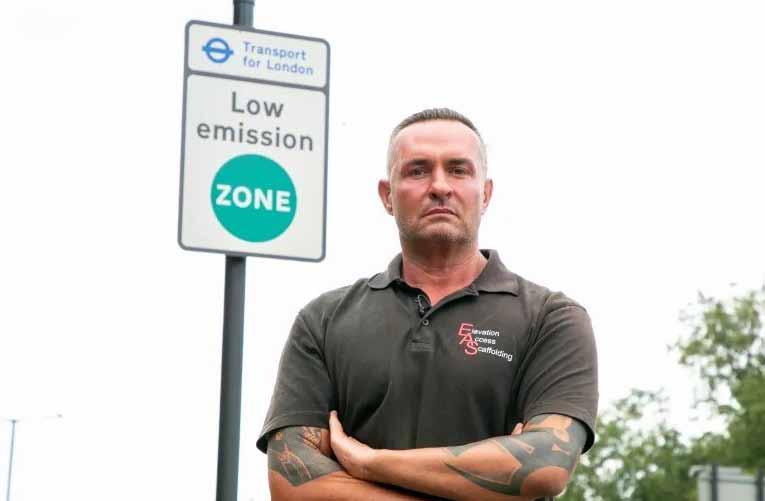
We're in the morning meeting on the orthopaedics trauma ward on the 10th floor at the Royal London Hospital in Whitechapel.
Like every morning, the team are here to talk through the cases that will face them in the day ahead, and a familiar theme pops up.
From one side of the room a surgeon talks about his patient: "A 32-year-old, fit and well student... a couple of days ago he fell off an e-bike sustaining a closed left tibial plateau fracture."
And a few moments later a voice next to us describes another case: "Six-yearold girl, she was hit by an electric bike, she has a closed tib/fib fracture."
The little girl they are talking about is Frida.
She was out playing with friends in the park at the weekend when she was hit by someone on an electric bike.
It fell on her, breaking her tibia and fibula – bones in her lower leg.
Friday, a young girl, lies in a hospital bed asleep, with
surgeons operated –inserting pins that will help the bones heal.
But that healing process will take around a year.

her leg bandaged up. She has two teddies nearby. Her dad Ed sits beside her on a chair next to the bed and looks at her.
Frida's dad Ed says it's "crazy" that "big and heavy" electrically powered bikes are allowed to share park pathways with pedestrians
She was rushed to the Royal London, where
Her dad Ed sits beside her hospital bed, watching her sleep.
He said they had been preparing to head to Millfields Park on Saturday to join friends for a picnic. Frida had already gone ahead with them.
Then the phone rang to say there had been an accident.
"It seems like he was going probably going too fast to stop in time. It smashed into her," Ed says.
"They are so heavy these things, he came off it on to her, the bike landed on top of her."
I"It just seems crazy that they can be allowed to ride through public parks like that," says Ed.
"I understand how it can make sense for pedestrians and push bikes to share those paths, but for children to be sharing a path like that with an electric bike –they are so big and heavy – the damage they can do is really significant."
Ed said the cyclist "had no paperwork", and was in the UK working on a tourist visa, and didn't have a UK address or phone number.
He makes the point that if the e-bikes were classified as motorised, the cyclist would not have been able to ride it.
"It's just not OK that these accidents are happening, they seem to be happening more and more," he says.
Ed explained that his family and friends were now going to fight for more regulation around e-bikes, and said they had already written to the mayor and local MP.
"We are determined to see some changes made," he says.
Surgeon Jaison Patel is seeing more and more cases like this.
"It's a massive burden on our department and I'm sure it's the same across the whole of London," he tells us.
"If we can reduce the number of patients coming in with these sorts of injuries it would be great for the patients obviously, but also takes massive pressure off us in the NHS."
Courtesy of the BBC
On 13th September, licensed London taxi drivers joined a demonstration in central London. Unlike other occasions where the taxi trade has rallied for its own interests, this protest was about something broader and more profound: the growing sense that British culture is being eroded.
For many drivers, the black cab is not just a vehicle—it is a symbol of London itself, woven into the fabric of the city’s history and identity. To take part in a protest about the protection of culture and heritage is therefore a natural extension of what the badge represents: pride in our country, in our capital, and in traditions that should be preserved for future generations.
While drivers have every right to protest, it is vital to remember that your licence is your professional lifeline. Years of dedication, study, and sacrifice go into achieving the Knowledge and earning the right to carry passengers.
Any action that crosses into unlawful territory— whether during work or at a protest—can potentially put that licence at risk.
This doesn’t mean drivers should hold back from demonstrating. Far from it. But it does mean protests should be conducted responsibly: lawfully, safely, and with respect for others. In doing so, drivers protect both their personal badge and the reputation of the trade as a whole.

By Jamie Hawes, LCDC Heathrow Rep
At the heart of this issue lies something greater than the cab trade: the fundamental right of citizens to speak out about the direction of their country. Protest has always been central to British democracy. From the Chartists to the Suffragettes to modern
movements, the ability to gather and challenge those in power is a freedom generations have fought to protect.
To say nothing—to allow voices to be silenced—would be to let that tradition slip away. And just as culture can be eroded when it is neglected, so too can
freedom of expression. That is why it is essential for drivers, and indeed all citizens, to continue speaking up.
London’s taxi drivers often see themselves as custodians of the city. They carry its visitors, its residents, its stories.

They know its streets better than anyone, and in many ways, they are ambassadors for British culture. When that culture is threatened— whether by neglect, by outside forces, or by indifference—it is only natural that those who care deeply about it will want to act.
Taking part in a demonstration about British culture is therefore not just a political act, but a personal one. It is about ensuring that future generations still recognise the London and the Britain that drivers are so proud to represent today.
The key is balance. Demonstrate with passion, but do so responsibly. Protect the badge, but do not silence your voice. By showing that protests can be lawful, powerful, and dignified, drivers send a message that is harder to dismiss: that they are not only professionals but also engaged citizens who care about the wider future of their country.
The protest on 13th September was not about fares, ranks, or regulations. It was about something far deeper— the protection of British culture itself.
As licensed taxi drivers, you carry not only passengers but also the heritage of London. When you stand up for your culture, you stand in a long tradition of people who have refused to let their history, identity, and freedoms be eroded.
So the message is clear: guard your licence carefully, but never silence your voice. A culture preserved is a culture passed on—and it is only by speaking up, lawfully and proudly, that we ensure it survives.
Be lucky and most of all be careful out there.
How many times have we as drivers sat on a terminal rank & been approached by passengers who are apprehensive in their communication with us.
Why? Because they’ve been told how expensive we are just to get into Central London by the vermin that infects our arrivals halls.
This vermin has been allowed to run riot without any resistance from Heathrow Airport. Heathrow security have zero interest in enforcing the airport by-laws as most of the security come from the same background as the organised tout gang.
There is a conservative estimate of approximately 200-300 touts actively working across the 4 terminals at Heathrow Airport. That’s jobs lost from the taxi ranks.
Heathrow Airport have a duty of care for their passengers who travel through the airport & onward travel. Their complete neglect of security at the airport is disgraceful.
We have drivers coming from everywhere to tout, we have London Green Badge Taxi drivers sitting on the terminal drop off touting work. We have organised gangs touting in the terminal, these gangs tout indiscriminately & with impunity knowing
management decided it was too vigilante & would not be reinstated after everyone returned to the airport after Covid. I know this because I sat in the meeting where this was relayed to us.
Not one airport rep
cab in the wrong place & watch it being ticketed or towed away yet Aviation policing turn a blind eye to any tout.
They’re more interested in sitting in McDonald’s or the canteen than doing their jobs.

that nobody is going to do anything. They’re charging passengers £250-£300 for a journey into Central London.
We had a tout squad at the airport but Heathrow
could believe what we were hearing & we told them so. Unfortunately Heathrow & the Police force that’s responsible for the security and safety of this airport deem it a low priority. Park your
Our passengers & our work is being stolen from our ranks because they claim we don’t have the money for it, well that’s a lie because they have £2.4 million of our money that’s sitting in an
account somewhere as our overpayment from the feeder park fees paid for by you the drivers.
We have a new despatch system coming soon. Where did the finance come for that & who signed it off. We’re getting a system that’s not been tested yet we’ve paid handsomely for it. Again we’re none the wiser as to how it’s really going to work yet again we’ve paid for it.
Did we have a say in how it would work? No we were never asked, Heathrow acts as a dictatorship towards the Taxi trade, informing after the fact rather than consulting & working together. We were informed of the parking & waiting restrictions on Newall Road at the last minute contrary to popular beliefs that it was the LCDC that made it happen.
If we had that power there’d be massive changes at Heathrow, I can assure you that.
Gary Long
LCDC Rep

When waiting at the traffic lights on Northumberland Avenue, looking towards the River Thames, have you noticed the commemorative plaque of Sir Joseph Bazalgette on Victoria Embankment?
I regard Bazalgette as one of the most remarkable engineers and designers of the nineteenth century. His work has had an immeasurable impact on London, shaping not just its infrastructure, but much of its aesthetic character today. Currently, more than ever, we need a visionary who, like Bazalgette, can enhance London both practically and aesthetically.
Sir Joseph Bazalgette was an English civil engineer who rose to prominence in 1852 when he was appointed Chief Engineer of London’s Metropolitan Board of Works (MBW). This board was eventually superseded by the LCC, then the GLC, and now the GLA under the direction of the current Mayor, whose recent proposals seem intent on disrupting some of London’s historic engineering feats and embankments, plus closure of corporate movement that contributes immensely to London’s success.
Ascetically, London in certain areas has become a mess and quite frankly dangerous, cycle lanes going against the flow of traffic on a one way street for example.
However, Bazalgette’s legacy endures, and his most notable contribution was the creation of the London Main Drainage, the sewerage system that helped prevent cholera outbreaks and relieved the city during the infamous Great Stink of 1858. Bazalgette’s sewer system lasted 175 years and is currently being updated. His monumental achievement
not only saved lives but began the long process of restoring the River Thames to a cleaner state.
Yet Bazalgette’s vision extended far beyond the design of a sewage system. He was also behind the construction of the Thames Embankments, a project designed to improve both the functionality and beauty of the city. The embankments, built during the Victorian era as part of the Thames Improvement Scheme, stretched from Blackfriars Bridge to Battersea Bridge. His goal was two fold: to reclaim land for urban development and prevent flooding, while creating beautiful boulevards and scenic walkways that would serve Londoners for generations.
Both Chelsea Embankment and Battersea Park Embankment had long been vulnerable to frequent flooding, and the areas surrounding them were prone to erosion. The Chelsea Physic Garden, for instance, only survived due to a protective brick wall erected in the late 1700s. In this context, Bazalgette’s project was visionary. It wasn’t just about infrastructure; it was about transforming a waterfront once prone to flooding into a carefully crafted public space that residents could enjoy.
When the embankments were initially designed, they featured wide pavements, ornate gas-lit lamps, and the iconic planting of London Plane trees, many of which remain along Victoria Embankment, the oldest of their kind in the city. These elements, intended to beautify and serve the public, reflect Bazalgette’s understanding of urban design as a blend of practicality and aesthetic pleasure.
In the 1850s, as the importation of goods by sea expanded, London became a hub for maritime trade. The city’s docks were busy with ships unloading goods, which required secure dockside platforms. To accommodate the surge in traffic, the Royal, Victorian, and King George V Docks were created. These massive docks were dug out by English and Irish labourers using rudimentary tools, with the excavated earth being transported up the Thames on sailing barges. This earth was
gathering—qualities that made London’s riverfront a celebrated space.
Following the completion of the Chelsea Embankment, the iconic Albert Bridge was built. Designed by engineers John Fowler and Benjamin Baker and opened in 1873, the bridge faced early safety concerns due to its swaying suspension section. Although it wasn’t originally part of Bazalgette’s work, he offered his expertise to ensure the bridge’s stability. His solution involved sinking piers into the riverbed to provide additional support for the central section of the bridge. Although those piers are still in use today, the 1972 upgrade incorporated new piers using stronger construction methods and materials.

ultimately used to shape the grounds of Battersea Park, which was transformed from a vast mudflat into the park we see today. The park’s gardens, designed by the landscape architect James Pennethorne, became a popular space for both relaxation and recreation, with winding paths, a lake, and meadows.
While these developments were already ambitious, Bazalgette’s oversight ensured that the entire project maintained a balance of functionality and beauty. The embankments on both sides of the river would provide not just transportation routes but spaces for leisure and public
Bazalgette’s legacy also extends to the design of Battersea Bridge, as well as the upgrades to several key crossings, including Hammersmith Bridge, which opened in 1887. His role in these projects contributed to London’s evolving infrastructure, making the city more accessible while enhancing its connectivity.
Today, Chelsea Embankment is celebrated for its stunning views, its proximity to historical landmarks such as the Chelsea Physic Garden and Battersea Park, and its iconic role in London’s landscape. Bazalgette’s foresight in overseeing street widenings and riverfront developments helped manage the city’s growing population and growing urban needs.
Though Bazalgette is often best known for his work on flood prevention and sanitation, his role in urban planning should not be underestimated. He designed systems to manage flooding, particularly through the creation of embankments in Westminster that helped control the course of the river. He also oversaw public works that included road widening elswhere, the creation of public parks, and the construction of key bridges. His expertise helped lay the foundation for the modern urban infrastructure that London relies on today.
Bazalgette's understanding of the link between commerce, infrastructure, and prosperity was integral to his vision. He knew that a city like London, with its growing importance in global trade, needed to keep moving. Efficient transport routes, functional public spaces, and access to trade were key to maintaining London’s position as a centre of commerce and industry. At the same time, Bazalgette was careful to preserve London’s rich historical character, creating a city that could grow and modernise while still respecting its past.
As London evolves, we should remember the visionary work of Sir Joseph Bazalgette and the lasting impact he had on the city's development. His contributions are not just engineering feats but also a legacy of public service and civic pride.
Be proud of London and its history, and let’s continue to uphold the spirit of innovation and civic responsibility that Bazalgette championed.
Be Lucky, Jim in London
London cab driver and Taxi Charity for Military Veterans trustee, Daren Parr, swapped his taxi for a mystery bus, appearing in the hit BBC TV series Destination X.
Daren, 59, has been a London taxi driver for 21 years and a proud volunteer with the Taxi Charity for 12 of them. Earlier this year, he was delighted to be invited to join the charity as a trustee. His passion for service, adventure, and storytelling made him a natural fit for Destination X, where contestants travel across Europe without knowing their location, competing in challenges along the way.
“I was contacted through my ‘cabbiesdoatlanticrow’ Instagram page and invited to take part,” explains Daren. “I think I had four interviews in total, one of them involved building a replica of the Burj Khalifa out of cardboard boxes!”
This wasn’t Daren’s first taste of adventure. At 42, he featured in Extreme Dreams with Ben Fogle, travelling to Uganda and Venezuela. He has also undertaken fundraising challenges for the Taxi Charity, including climbing Mount Meru and Kilimanjaro and rowing the Atlantic from Lanzarote to Antigua.
On Destination X, Daren relished the mystery and camaraderie. “It was exciting and great fun. We never knew where we were, apart from BadenBaden and Venice. The rest of the time we were completely in the dark,” he recalls. “Rob Brydon was a fantastic host, very witty and down to earth and I struck up a brilliant
friendship with surfer Ben. We were so different, but we clicked straight away.”
Daren reached the semi-final, bowing out in Monaco after misinterpreting a clue that led him to think of the Louvre instead. “I certainly didn’t deserve to win, the others were much better than me but I was over the moon to get as far as I did. And honestly, I’m not sure how they’d have got me into one of those sidecars in the final!”
Among his favourite destinations was Austria, which he hopes to revisit with his wife Jacky. “Salzburg took my breath away,” he said, though he admits one night in Moosham Castle, infamous for its grisly history of torture, was more than enough.
Back in London, Daren continues to combine cab driving with his volunteering for the Taxi Charity.
“I see it as giving something back to those who sacrificed so much for this country,” he says. “Every trip with the veterans is memorable, but standing on Sword Beach in Normandy for the 80th anniversary of D-Day with WWII veteran Bob Gravells was an honour I will never forget.”
Since the show aired, Daren has been delighted by the public response. “The reaction has been incredible, people come up to me all the time to ask if I’m the cabbie from Destination X,” he said. “I even got invited as a guest to Millwall, my lifelong team, where I had a fantastic day meeting players old and new, despite the 2–0 loss to Wrexham.”
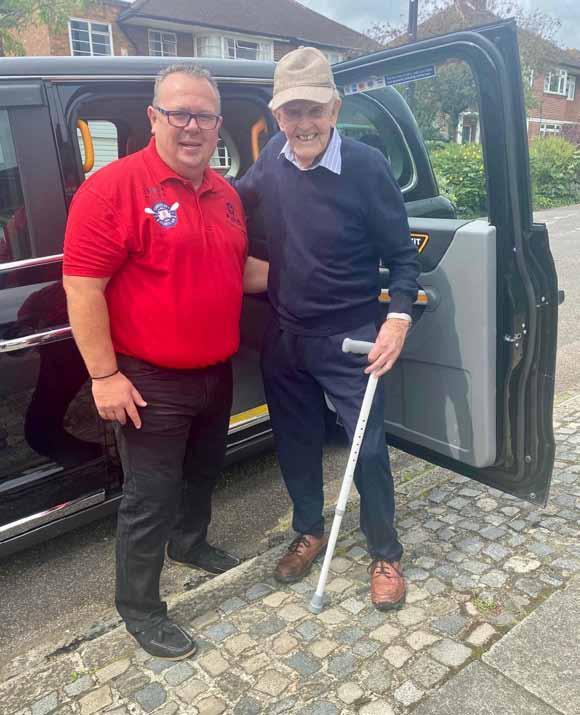
From the streets of London to the beaches of Normandy and the adventures of Destination X, Daren Parr continues to embody the spirit of service, humour, and resilience that define both the London taxi trade and the Taxi Charity for Military Veterans.
The Taxi Charity is run by volunteer London
black taxi drivers and has been supporting thousands of veterans since 1948.
It is the only Forces charity that focuses on providing fun and entertainment and arranges free trips (for veterans from all conflicts) to the Netherlands and France for acts of commemoration and days out to museums, concerts, or social events across the UK.

The charity received the Queen’s Award for Voluntary Service in 2021 and celebrated its 75th anniversary in 2023, a remarkable milestone for a small, niche charity peopled by enthusiastic volunteers.
To fund and facilitate their work, the charity is wholly reliant on donations, grants and sponsorship.
www.taxicharity.org




They filled the arenas and pubs and streets every time Ricky Hatton fought, and they sang “there is only one Ricky Hatton” until dawn.
Ricky Hatton was the council estate boy who grew up in a pub and took about 60,000 fans to Las Vegas when he was one of boxing’s top attractions. He was British boxing’s most popular boxer, and that title feels like it will be his crown for a long, long time.
He won world title fights at 3am against the odds in his beloved Manchester, and he went down in glory in massive fights on other unforgettable nights in Las Vegas; each time the fans sang their endless chorus of devotion. And it was true; there was only one Ricky Hatton.
Hatton turned professional one night in 1997 at a leisure centre in Widnes and won, obviously. His name was not even on the poster, he was never the chosen one, the golden boy, the poster boy. He was just a kid from Manchester with a bit of amateur pedigree and a style that fans liked.
After all his fights in Manchester back then, he would have a Sunday special in his local, hosting a s*** shirt competition and drinking. The fans increased, the stories started to circulate – the kid who was not on the poster for his debut was suddenly selling a lot of tickets, and he was the poster.
He was matched hard after six or seven easy fights and he improved, taking care of good domestic fighters –and then he won the British title. In his 23rd fight, he won a version of the world title, which led to the run of fights at the old MEN Arena, and it was clear straight away that Hatton was adored. The
Hatton party was about to launch.
Hatton fought at the MEN 12 times between 2001 and 2005, each time the crowds increased, the noise changed, and he became established as British boxing’s number one attraction.
It is hard to explain what happened in 11 of those fights when it was just the WBU belt on the line; then it was Kostya Tszyu, the great champion, and a fight at the MEN in the middle of the night. The bars were closed inside the MEN
Ricky collapsed in rapture and pain to the canvas, it was close to 2am and Hatton was a global star. That was a serious party, a festival.
Soon after that win, Hatton took his army on the road to Las Vegas for a trio of world title fights in 2007; British boxers had been in Las Vegas before and taken fans with them, but the Hatton numbers were simply overwhelming. His fans never stopped singing, gambling or drinking.
It is estimated by the United States Citizenship
over 50,000 attended his fight with Juan Lazcano at his beloved Etihad. It was a shutout win, and then it was back to Las Vegas for two more fights, including the awful night with Pacquiao back at the MGM. The fans stayed loyal and held vigils when he walked away from the sport in 2009.
Hatton’s exit from the glory was difficult from the start. The boxer confronted his demons in a series of heartbreaking interviews.
“Night after night,” he said in one. “I just couldn’t kill myself.” That is raw, honest and raw.
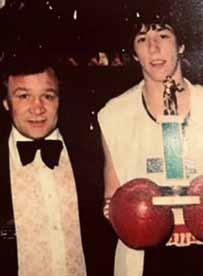
By Steve Bunce
his addictions, and he confronted his mental health, and he spread the word that it is “OK to not be OK”. And he used his humour at all times – he was a very funny man.
At the time of his death, Hatton was preparing for an exhibition fight in Dubai.
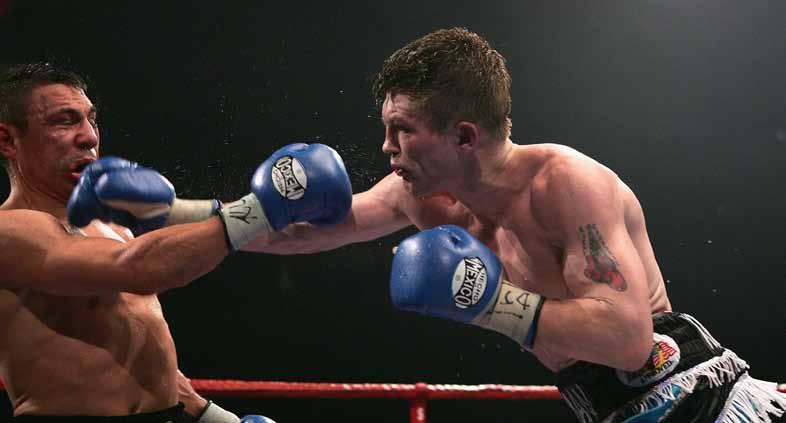
before midnight; the place was heaving with just under 20,000 avid fanatics there for their idol.
It was wild down at ringside, and then the first chords of “Blue Moon” started to fill the space in Hatton’s sacred venue. It was an exceptional night, both boxers were exhausted when Tszyu was pulled out at the end of the 11th. There was bedlam that night as
and Immigration Services that more than 30,000 British people flocked to the city for the Floyd Mayweather fight in December 2007. There were 10,000 at the weighin. Hatton owned Las Vegas, but the Mayweather stoppage was heavy on his heart; the Manny Pacquiao defeat in 2009 would crush him.
The following year, just
He was desperate, and he had one more fight, one more night back at the MEN in his own neon excellence. He wondered if the limelight would cure the darkness; it never did. He lost, and the chorus was even louder. There were more dark, dark days to come.
Hatton was clearly a deeply troubled man, and he never avoided his own problems. He confronted
He looked in good shape, sounded fine and was planning on being in Dubai this week for a conference. There would have been more singing, no doubt, but the Hatton choir will never fall silent in admiration of a man they adored. Hatton gave his fans all that he had on both sides of the ropes.
He was, without doubt, the People’s Champion.
The history of Anello & Davide, originally shoemakers to the ballet, dance and theatrical world, is a captivating tale of tradition meeting modernity in the heart of London. Founded in Covent Garden in 1922, they quickly became synonymous with timeless elegance and exquisite craftsmanship that combined Italian design, flair and English tradition.
From its shop at 96 Charing Cross Road (they later moved to number 30 Drury Lane circa 1965) they specialised in ballet shoes and theatrical footwear as well as later making high quality fashion footwear for men and women. Their ability to cater for the diverse needs and preferences of their customers, whether it was a classic Oxford shoe for a formal affair or a stylish Chelsea boot for a night out on the town, meant the brand could go on to offer a wide range of styles to suit any occasion. Each design was meticulously crafted, using only the finest materials sourced from renowned suppliers, ensuring that every pair of shoes upheld the brand’s commitment to quality and durability.
Among those who discovered the shop, were the Beatles. During the height of the early days of Beatlemania, Anello & Davide became a trusted supplier of custom-made boots and shoes for band members, John, Paul, George and Ringo, who turned to the esteemed shoemaker to create footwear that reflected their evolving personal styles and complemented their stage presence.
It is said the Fabs first noticed Chelsea boots with Cuban heels worn by a London band, whilst they were out playing in Hamburg in their formative years. Upon their return to the UK in late 1961, they visited the shop to buy the boots

and bought ourselves Beatle boots, which were basically Spanish dancing boots. They were a cool thing before the Beatles, but afterwards they were mandatory.’ – Mick Fleetwood.
and then later returned to commission different variations in other colours and fabrics, and the Beatle boot was born.
They were characterised by their streamlined silhouette and Cuban heel, and quickly became synonymous with the band’s emerging ‘smart’ image with a nod to the pervading mod fashion of the early to mid 1960s.
direct descendant of the Chelsea boot, from which the pointed toe and centre seam stitch (running from ankle to toe) was derived, and the Flamenco boot, from which the Cuban heel was derived. The
men were soon queueing outside the shop, demanding the same styles. A&D then built on their raised profile to become known as sellers of fashionable streetwear. The styles ranged from
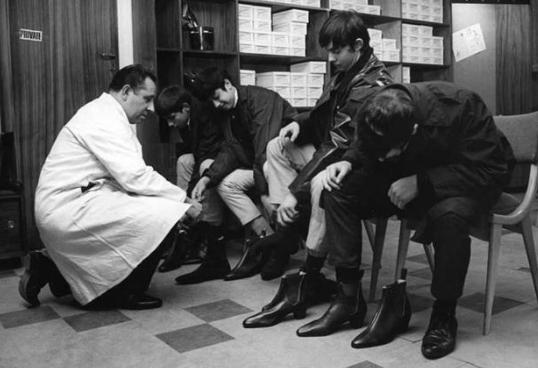
style would then feature an elastic gusset or a zipper.
The boot was in fact a
From that first fortuitous meeting between the shop and the Fabs and the resultant massive publicity, crowds of young
Other pop performers and 60s icons who also wore the Anello and Davide label include Mark Feld (later Marc Bolan of course) Roy Orbison, Mick Jagger and photographer David Bailey. In fact, they weren’t strangers to the world of celebrity at the shop, numbering Orson Welles, Marilyn Monroe and David Niven among previous customers. Among the films they supplied footwear for, included, being involved in making the red slippers for Dorothy in The Wizard of Oz, and later Star Wars, and Indiana Jones. Theatre credits include Cats, Miss Saigon, 42nd Street and Mamma Mia.
In early 2009 the company had a serious fire at their warehouse in Park Royal, resulting in a loss of machinery and stock, as well as the foot casts of their customers, including Queen Elizabeth II, who wore A&D leather slip-ons for over fifty years. She wore size 4, in calf leather, often with a brass ornamentation, and the style were known as her ‘work’ shoes.’ These came in mostly black, though other colours were also ordered. It is reported she had a servant – named Cinders – who wore them in for her!
In 2004, Anello & Davide produced a ready to wear collection for men, but in truth their hey-day was gone.
tap dancer shoes to black leather kinky knee length boots for the likes of Mary Quant.
‘As a band, like a thousand others, we all went to a shoe shop called Anello & Davide
A Google search tells me they are still in operation making handmade shoes, but I can’t locate a shop. Of course, if any of you know differently, you know where to find me.
www.artgalleryclothing. co.uk/blog/

All under one roof
• Exclusive Insurance schemes
• Breakdown cover only £99
• Roadside assistance and recovery
• Recovery to any UK Location